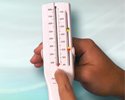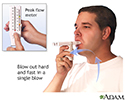How to use your peak flow meter
Peak flow meter - how to use; Asthma - peak flow meter; Reactive airway disease - peak flow meter; Bronchial asthma - peak flow meter
A peak flow meter is a small device that helps you check how well your asthma is controlled. Peak flow meters are most helpful if you have moderate to severe persistent asthma.
Asthma
Asthma is a disease that causes the airways of the lungs to swell and narrow. It leads to wheezing, shortness of breath, chest tightness, and coughi...

How to Measure Peak Flow
Measuring your peak flow can tell you and your health care provider how well you blow air out of your lungs. If your airways are narrowed and blocked due to asthma, your peak flow values drop.
You can check your peak flow at home. Here are the basic steps:
- Move the marker to the bottom of the numbered scale.
- Stand up straight.
- Take a deep breath. Fill your lungs all the way.
- Hold your breath while you place the mouthpiece in your mouth, between your teeth. Close your lips around it. DO NOT put your tongue against or inside the hole.
- Blow out as hard and fast as you can in a single blow. Your first burst of air is the most important. So blowing for a longer time will not affect your result.
- Write down the number you get. But, if you coughed or did not do the steps right, do not write down the number. Instead, do the steps over again.
- Move the marker back to the bottom and repeat all these steps 2 more times. The highest of the 3 numbers is your peak flow number. Write it down in your log chart.
Many children under age 5 cannot use a peak flow meter very well. But some are able to. Start using peak flow meters before age 5 to get your child used to them.
Find Your Personal Best
To find your personal best peak flow number, take your peak flow each day for 2 to 3 weeks. Your asthma should be under control during this time. To finding your personal best, take your peak flow as close to the following times of day as you can:
- Between noon and 2 p.m. each day
- Each time after you take your quick-relief medicine to relieve symptoms
- Any other time your provider tells you to
These times for taking your peak flow are only for finding your personal best.
Write down the number you get for each peak flow reading. The highest peak flow number you had during the 2 to 3 weeks is your personal best.
Ask your provider to help you fill out an asthma action plan. This plan should tell you when to call the doctor for help and when to use medicines if your peak flow drops to a certain level.
Your personal best can change over time. Ask your doctor when you should check for a new personal best.
Use Your Peak Flow Meter Every Day
Once you know your personal best, make taking your peak flow a habit . Take your peak flow:
Make taking your peak flow a habit
Asthma - make peak flow a habit; Reactive airway disease - peak flow; Bronchial asthma - peak flow
- Every morning when you wake up, before you take medicine. Make this part of your daily morning routine.
-
When you are having asthma symptoms or an
attack
.
Attack
Asthma attack - signs of; Reactive airway disease - asthma attack; Bronchial asthma - attack
Read Article Now Book Mark Article -
After you take
medicine for an attack
. This can tell you how bad your asthma attack is and if your medicine is working.
Medicine for an attack
Asthma - quick-relief drugs - short-acting beta-agonists; Asthma - quick-relief drugs - bronchodilators; Asthma - quick-relief drugs - oral steroids;...
 ImageRead Article Now Book Mark Article
ImageRead Article Now Book Mark Article - Any other time your doctor tells you to.
Check to see which zone your peak flow number is in. Do what your provider told you to do when you are in that zone. This information should be in your action plan. If you use more than one peak flow meter (such as one at home and another one at school or work), be sure that all of them are the same brand.
References
Durrani SR, Busse WW. Management of asthma in adolescents and adults. In: Adkinson NF Jr, Bochner BS, Burks AW, et al, eds. Middleton's Allergy Principles and Practice . 8th ed. Philadelphia, PA: Elsevier Saunders; 2014:chap 55.
National Asthma Education and Prevention Program. How to use a peak flow meter. How to use a metered-dose inhaler. Last revised March 2013. www.nhlbi.nih.gov/health/public/lung/asthma/asthma_tipsheets.pdf . Accessed March 14, 2016.
Sveum R, Bergstrom J, Brottman G, et al. Institute for Clinical Systems Improvement. Diagnosis and management of asthma. Updated July 2012. www.icsi.org/_asset/rsjvnd/Asthma-Interactive0712.pdf . Accessed April 11, 2016.
-
How to use a peak flow meter
Animation
-
How to measure peak flow - illustration
Move the marker to the bottom of the numbered scale.Stand up straight.Take a deep breath. Fill your lungs all the way.Hold your breath while you place the mouthpiece in your mouth, between your teeth. Close your lips around it. Do not put your tongue inside the hole.Blow out as hard and fast as you can in a single blow. Your first burst of air is the most important, so blowing for a longer time will not affect your result.Write down the number you get. If you coughed or did not do the steps right, do not write down the number. Do it over again.Move the marker back to the bottom and repeat these steps 2 more times. The highest of the 3 numbers is your peak flow number. Write it down in your results log. Move the marker to the bottom of the numbered scale. Stand up straight. Take a deep breath. Fill your lungs all the way. Hold your breath while you place the mouthpiece in your mouth, between your teeth. Close your lips around it. Do not put your tongue inside the hole. Blow out as hard and fast as you can in a single blow. Your first burst of air is the most important, so blowing for a longer time will not affect your result. Write down the number you get. If you coughed or did not do the steps right, do not write down the number. Do it over again. Move the marker back to the bottom and repeat these steps 2 more times. The highest of the 3 numbers is your peak flow number. Write it down in your results log. highest
How to measure peak flow
illustration
-
How to measure peak flow - illustration
Move the marker to the bottom of the numbered scale.Stand up straight.Take a deep breath. Fill your lungs all the way.Hold your breath while you place the mouthpiece in your mouth, between your teeth. Close your lips around it. Do not put your tongue inside the hole.Blow out as hard and fast as you can in a single blow. Your first burst of air is the most important, so blowing for a longer time will not affect your result.Write down the number you get. If you coughed or did not do the steps right, do not write down the number. Do it over again.Move the marker back to the bottom and repeat these steps 2 more times. The highest of the 3 numbers is your peak flow number. Write it down in your results log. Move the marker to the bottom of the numbered scale. Stand up straight. Take a deep breath. Fill your lungs all the way. Hold your breath while you place the mouthpiece in your mouth, between your teeth. Close your lips around it. Do not put your tongue inside the hole. Blow out as hard and fast as you can in a single blow. Your first burst of air is the most important, so blowing for a longer time will not affect your result. Write down the number you get. If you coughed or did not do the steps right, do not write down the number. Do it over again. Move the marker back to the bottom and repeat these steps 2 more times. The highest of the 3 numbers is your peak flow number. Write it down in your results log. highest
How to measure peak flow
illustration
Review Date: 2/15/2016
Reviewed By: Neil K. Kaneshiro, MD, MHA, Clinical Assistant Professor of Pediatrics, University of Washington School of Medicine, Seattle, WA. Also reviewed by David Zieve, MD, MHA, Isla Ogilvie, PhD, and the A.D.A.M. Editorial team.


